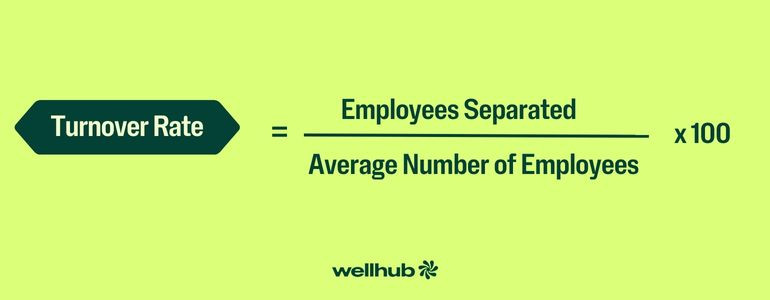How to Calculate and Reduce Your Employee Turnover Rate
Last Updated Jul 23, 2025

Employees are the foundation of any business, and business leaders sometimes take that foundation for granted — specifically, that it will always be there. Yet workforces are anything but static. Workers come and employees go in a constantly shifting dance as new positions open and veteran staffers move on to other opportunities. This is a natural part of working with people.
So, yes, turnover is natural — but it’s also expensive and, if you have a high churn rate, could be a sign of broader issues within the organization worth addressing. Here’s how you can calculate your turnover rate, how to interpret your number, and ways you can improve it.
What Is Employee Turnover?
‘Turnover’ is when employees leave a company, voluntarily or otherwise. ‘Turnover rate’, meaning the percentage of employees who leave a company during a specific period of time. This figure gives decision-makers a clearer picture of just how big of an issue turnover is in their organization. Turnover rate is the opposite metric to employee retention, which measures how many of your hires remain with the company.
What constitutes a ‘high’ turnover rate will vary from industry to industry — according to the US Bureau of Labor Statistics, the industries with the highest separation (turnover) rates in 2021 were ‘accommodation and food services,’ ‘leisure and hospitality’, and ‘arts, entertainment, and recreation’ with each showing a separation rate of about 75% – 85%. On average, US businesses during that time period saw a separation rate of 47.2%.
That said, most leaders agree that a turnover rate of about 10% is ideal, and Gallup agrees — provided that the 10% who are leaving represent the 10% who are least engaged in your organization. If the 10% turnover comes from your top performers, then that number is definitely still too high.
The lower this figure is, the better your business will be able to recoup its hiring investments and foster valuable, loyal talent. It can also contribute to improved outcomes for the organization overall. A high turnover can reduce institutional knowledge and cut into company culture, all of which reduce your organization’s capacity to serve your customers.
The High Cost of Employee Turnover
Excessive employee turnover carries with it a significant cost. When an established employee leaves your organization, the money and time you invested in recruiting, outfitting, licensing, and training that individual leaves with them. The employee’s job is suddenly vacant and their responsibilities either fall to another employee (potentially leading to burnout) or get put on hold (decreasing productivity). And, of course, locating and onboarding a suitable replacement means investing all over again.
How does this impact translate into dollars? Every business is different, but SHRM suggests that the average base cost of bringing on a new hire is about $4,700, and the total costs may be as high as three to four times the position’s annual salary. And there’s no guarantee that the new employee you bring on is going to stay long enough to offset that investment — research from Lattice says that approximately 52% of employees who have been with their companies for fewer than three months (and 60% who have been there for fewer than six months) are actively looking for new jobs.
Increased employee turnover also hurts employee engagement. When members of your workforce see their colleagues leave, it can take a major toll on your company culture. Employees begin to view their positions as unstable or start to think of the organization as a pit stop on the way to something better. This, in turn, can have a negative impact on employee morale, service quality, customer retention, and more.
Simply put, a high employee turnover is an issue that no company can afford to overlook. But how can you accurately track turnover in your business?
How to Calculate Employee Turnover Rate
While many factors influence turnover rate, calculating the turnover rate is straightforward. A basic equation for determining total turnover is as follows:

So, if you start the year with 500 employees and you lose 80 people during that time, then your overall turnover rate would be 16%: (80 separations / 500 employees) x 100 = 16% turnover rate.
What is a Good Employee Turnover Rate?
A “good” (i.e., healthy) turnover rate largely depends on your industry, but most HR experts agree that around 10% annual turnover is generally a balanced target. That allows for natural renewal while minimizing disruption. The U.S. average is about 10 to 12%.
Average Employee Turnover Rate by Industry
- Technology: ~60% annually—driven by layoffs and voluntary moves
- Manufacturing: ~28.6%
- Retail/Wholesale: ~32.9%
- Banking & Finance: ~19.8%
- Healthcare: Hospitals ~22.7%, Nursing homes ~53.3%, Home health ~31.1%
- Government: ~25%
- Education & Health Services: ~50
How to Interpret Your Turnover Rate
With that percentage in hand, you’re much closer to putting your turnover rate to good use in improving employee retention. But just landing on a percent probably won’t tell you the whole story. To more fully understand your turnover rate, you need to put it into context.
Voluntary Turnover
Voluntary turnover occurs when employees choose to leave an organization on their own. This includes resignations for personal reasons, career advancement, dissatisfaction with the role or company, or other external factors. High voluntary turnover can be a red flag, especially when top performers or mission-critical roles are affected. It may point to deeper issues in employee engagement, leadership, or compensation.
Involuntary Turnover
Involuntary turnover refers to separations initiated by the employer. This includes terminations for performance, layoffs due to restructuring, or role redundancy. While some involuntary turnover is necessary and strategic (e.g., underperformance), consistently high rates can indicate hiring problems, unclear expectations, or poor leadership.
Identify Which Types of Employees Are Leaving
Not all employees bring the same value to your organization. As previously mentioned, if your turnover is highly disengaged employees, you can focus on improving your company’s employee engagement rates. If, on the other hand, your turnover rate includes your best and brightest, you may want to investigate possible systemic causes within the organization. These include issues like few growth opportunities or management inefficiencies, which require different solutions than employee disengagement.
Discover Why Your Employees Are Leaving
Some employees simply enjoy taking on new opportunities, but many people who quit had a reason they chose to look for other opportunities. Case in point: 79% of people who quit their jobs cite ‘lack of appreciation’ as a major factor in their decision. Conducting honest exit interviews with those who choose to terminate their employment can be a vital opportunity to solicit open feedback and identify issues that may be impacting your retention.
Of course, there’s no reason to wait until someone decides to quit to hear their opinions. Work environment surveys provide an easy and anonymous channel for employees to share their concerns and observations, so you can address potential problems before your best people start leaving.
How to Lower Your Turnover Rate
- Hire the Right People from the Start
Reducing turnover begins with hiring the right people. Organizations should focus on refining job descriptions to ensure they accurately reflect the responsibilities and expectations of the role. Using structured interviews and behavioral assessments can help identify candidates who are not only qualified but also aligned with the company’s values and culture. Involving current team members in the interview process is another way to ensure a good fit and build early buy-in. By prioritizing job fit and cultural alignment from the beginning, companies can significantly reduce early-stage turnover.
- Improve Onboarding and Early Engagement
A strong onboarding experience is essential for retaining new hires. Research shows that a significant percentage of turnover occurs within the first 45 days of employment, often due to poor integration or lack of support. To counter this, companies should implement structured onboarding programs that go beyond administrative tasks. Assigning a mentor or buddy can help new employees feel welcome and supported. Setting clear 30-, 60-, and 90-day goals, along with regular check-ins, ensures that expectations are aligned and that new hires feel seen and valued during their transition into the organization.
- Foster Career Growth and Development
Lack of growth opportunities is one of the most commonly cited reasons for voluntary turnover. To retain top talent, companies must demonstrate a clear commitment to employee development. This can include offering access to training programs, certifications, and mentorship, as well as creating individual development plans tailored to employee goals. Encouraging internal mobility and promoting from within not only boosts morale but also shows employees that their career can thrive within the company, reducing the temptation to look elsewhere for advancement.
- Train and Empower Great Managers
Managers play a critical role in employee retention. In fact, poor management is often a top reason employees choose to leave. Organizations should invest in leadership development to ensure that managers are equipped with the skills they need to lead with empathy, provide constructive feedback, and support employee growth. Monitoring engagement and turnover trends at the team level can help identify management-related issues early. When managers are empowered and supported, they foster healthier team dynamics, which contributes significantly to retention.
- Prioritize Employee Feedback and Action
Employees who feel their voices are heard are more likely to stay committed to their organizations. Soliciting regular feedback through engagement surveys is a good starting point, but the real impact comes from acting on that feedback. Stay interviews—informal conversations with current employees about their experience—can reveal valuable insights into what keeps people engaged and what might drive them to leave. Exit interviews should also be used strategically to identify recurring themes. By listening actively and responding meaningfully, companies can build trust and strengthen loyalty.
- Review and Enhance Compensation & Benefits
While compensation isn’t always the primary reason employees leave, it becomes a critical factor when it is perceived as unfair or below market standards. Employers should conduct regular benchmarking to ensure their pay and benefits packages are competitive. Beyond salary, offering a comprehensive benefits package—including wellness programs, mental health support, remote work flexibility, and family-oriented perks—can make a significant difference in how employees perceive the value of staying. Transparency around compensation structures and equity can also build trust and reduce attrition.
- Build a Culture of Belonging and Purpose
Employees are more likely to stay when they feel a sense of belonging and purpose at work. Cultivating a mission-driven culture that clearly communicates how each role contributes to the company’s goals can boost engagement. Recognition programs that celebrate achievements, inclusive policies that support diversity, equity, and inclusion, and opportunities for connection—especially in hybrid or remote environments—help create a workplace where employees feel seen and valued. A strong culture isn't just a retention strategy; it’s a competitive advantage.
- Monitor Turnover Data—and Act on It
Finally, companies must track and analyze turnover data in a meaningful way. It’s essential to differentiate between voluntary and involuntary turnover and examine trends by department, tenure, and role. Patterns—such as spikes after performance reviews or high turnover among new hires—can offer important clues. Combining these insights with qualitative data from interviews and surveys helps organizations develop targeted interventions. Turnover metrics shouldn’t just be reported—they should drive continuous improvement in HR and leadership practices.
Support Employees to Decrease Turnover Rates
Decreasing your turnover rate is within your power. Employees provide many reasons in their interviews for leaving — they found a higher salary, they don’t feel challenged where they are, they are burnt out juggling work and home life. But all of these motivators have the same root cause: the employee sees leaving this position as beneficial to their wellbeing in some way.
You can address many employee concerns about their wellbeing through a wellness program. After all, workers cite ‘wellness benefits’ as the second most important aspect of a job offer! People are happy to stay somewhere they are thriving.
If you want to talk through how a wellness program can help increase your employee engagement and satisfaction, talk to a Wellbeing Specialist today!

Company healthcare costs drop by up to 35% with Wellhub*
See how we can help you reduce your healthcare spending.
[*] Based on proprietary research comparing healthcare costs of active Wellhub users to non-users.
References
- Annual average job openings rates by industry and region, not seasonally adjusted. (2023, March 8). Bureau of Labor Statistics. Retrieved September 1, 2023, from https://www.bls.gov/news.release/jolts.t16.htm
- Job Openings and Labor Turnover Survey News Release. (2022, March 9). Bureau of Labor Statistics. Retrieved September 1, 2023, from https://www.bls.gov/news.release/archives/jolts_03092022.htm
- Navarra, K. (2022, April 11). The Real Costs of Recruitment. SHRM. Retrieved September 1, 2023, from https://www.shrm.org/resourcesandtools/hr-topics/talent-acquisition/pages/the-real-costs-of-recruitment.aspx
- Research Reveals Great Resignation Trends. (2022, April 12). Lattice. Retrieved September 1, 2023, from https://lattice.com/library/lattice-research-reveals-great-resignation-trends
- Smith, B., & Rutigliano, T. (2002, February 4). The Truth About Turnover. Gallup News. Retrieved September 1, 2023, from https://news.gallup.com/businessjournal/316/truth-about-turnover.aspx
Category
Share

The Wellhub Editorial Team empowers HR leaders to support worker wellbeing. Our original research, trend analyses, and helpful how-tos provide the tools they need to improve workforce wellness in today's fast-shifting professional landscape.
Subscribe
Our weekly newsletter is your source of education and inspiration to help you create a corporate wellness program that actually matters.
Subscribe
Our weekly newsletter is your source of education and inspiration to help you create a corporate wellness program that actually matters.
You May Also Like

18 Ways to Lower Workplace Stress for Teams | Wellhub
Combat burnout, boost morale, and reduce turnover with stress reduction strategies every HR leader can use to build a healthier workplace.

Quiet Quitting: What It Is, Causes, and Solutions | Wellhub
Quiet quitting signals low engagement and burnout. Learn what causes it and how to prevent it through support and balance.

How to Help a Workaholic Employee | Wellhub
Is your employee a workaholic? Discover the signs, causes, and how to help a workaholic achieve better work-life balance and improve productivity.